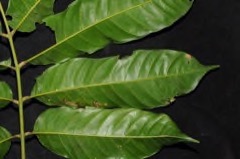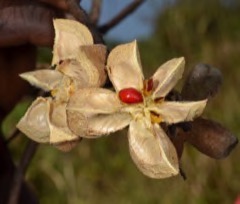 |
|
www.centralafricanplants.senckenberg.de/ |
 |
| www.centralafricanplants.senckenberg.de/ |
Translate this page:
Summary
Leplaea cedrata or commonly known as Scented Guarea is an evergreen tree reaching a height of up to 55 m. It has a straight and cylindrical bole that can be branchless for up to 26 m, with a diameter of up to 150 cm. It is found in lowland rainforest to semi-deciduous forests in tropical Africa. The bark is used in traditional medicine to treat stomach pain, gonorrhea, food poisoning, kidney pain, rheumatism, and leprosy. It also contains essential oil. The wood is medium-weight, moderately durable, and easy to work. It is used for flooring, joinery, interior trim, doors, ship building, cabinets, furniture, crates, plywood, veneer, and panelling.
Physical Characteristics

 Leplaea cedrata is an evergreen Tree growing to 45 m (147ft) by 30 m (98ft) at a slow rate.
Leplaea cedrata is an evergreen Tree growing to 45 m (147ft) by 30 m (98ft) at a slow rate.
See above for USDA hardiness. It is hardy to UK zone 10. The plant is not self-fertile.
Suitable for: light (sandy), medium (loamy) and heavy (clay) soils, prefers well-drained soil and can grow in nutritionally poor soil. Suitable pH: mildly acid and neutral soils. It can grow in full shade (deep woodland) semi-shade (light woodland) or no shade. It prefers moist soil.
UK Hardiness Map
US Hardiness Map
Synonyms
Guarea alatipetiolata De Wild. Guarea cedrata (A.Chev.) Pellegr. Khaya canaliculata De Wild. Trichil
Plant Habitats
Edible Uses
References More on Edible Uses
Medicinal Uses
Plants For A Future can not take any responsibility for any adverse effects from the use of plants. Always seek advice from a professional before using a plant medicinally.
Antirheumatic Kidney Leprosy
The bark is used in traditional medicine. Bark decoctions or macerations are taken to treat stomach-ache, food poisoning and gonorrhoea, and used as a wash against kidney pain, bleeding after childbirth, rheumatism and leprosy[299 ]. An essential oil and limonoids, including dregeanin, have been isolated from the bark[299 ].
References More on Medicinal Uses
The Bookshop: Edible Plant Books
Our Latest books on Perennial Plants For Food Forests and Permaculture Gardens in paperback or digital formats.

Edible Tropical Plants
Food Forest Plants for Hotter Conditions: 250+ Plants For Tropical Food Forests & Permaculture Gardens.
More

Edible Temperate Plants
Plants for Your Food Forest: 500 Plants for Temperate Food Forests & Permaculture Gardens.
More

More Books
PFAF have eight books available in paperback and digital formats. Browse the shop for more information.
Shop Now
Other Uses
Charcoal Essential Fuel Furniture Paper Wood
Agroforestry Uses: The trees are sometimes left after forest clearing to serve as shade trees for coffee and cocoa plantations[299 ]. Other Uses The bark contains an essential oil, which consists exclusively of sesquiterpenes, with as major constituents ß -caryophyllene (45%) and globulol (11%)[299 ]. The heartwood is pale pinkish brown when freshly cut, darkening to reddish brown upon exposure. It is usually distinctly demarcated from the yellowish white, 5 - 10 cm wide sapwood[299 ]. The grain is straight or interlocked, texture fine to moderately coarse. The wood sometimes shows a mottled or curly figure, and has a cedar-like smell when fresh. It may have a gummy exudate[299 ]. The wood is medium-weight, moderately durable and only occasionally attacked by termites and pinhole borers[299 ]. It is usually fairly easy to saw and work, with moderate blunting effects on cutting edges because the wood contains some silica (up to 1.0%). It can be finished to a smooth surface, but there may be a slight tendency to pick up in planing quarter-sawn material and gum may appear at the surfaces. The wood holds nails and screws well, but may split upon nailing. It glues satisfactorily except when gum is present; the use of a filler is recommended for staining and polishing. The bending properties are usually satisfactory. The heartwood is strongly resistant to impregnation, the sapwood permeable to moderately resistant. The wood is valued for house building, flooring, joinery, interior trim, panelling, window frames, doors, ship building, vehicle bodies, furniture, cabinet work, decorative boxes, crates, veneer and plywood. It is suitable for musical instruments, toys, novelties, carving and turnery, but gum exudation may have adverse effects on the products[299 , 886 ]. Good-quality veneer can be produced by both rotary cutting and slicing, the wood is also suitable for pulping to make paper[299 ]. Traditionally, the wood is used for dug-out canoes[299 ]. The wood is also used as fuel wood and for charcoal production[299 ].
Special Uses
References More on Other Uses
Cultivation details
A plant of the moister, lowland tropics up to elevations of 1,100 metres. It is found in regions with more than 1,600 mm annual rainfall and attains its highest density in regions with 2,000 mm annual rainfall[299 ]. Prefers a well-drained soil, tolerating infertile soils[299 ]. The tree is classified as a shade-bearer[299 ]. Seedlings are most common in the shade, although they are occasionally found in full sunlight. They are often even common in deep shade, where they can survive for a long time[299 ]. All sizes of seedlings and saplings are less abundant in forest affected by recent logging, in comparison with undisturbed, not too dense forest[299 ]. However, for further development, some opening of the forest canopy seems essential[299 ]. Initial growth of seedlings is slow, less than 30 cm after 1 year[299 ]. They show their best growth at 10% of full sunlight. If they are exposed to more sunlight after 1 year, growth may speed up, reaching annual growth rates of up to 1 metre in height in plots managed by the tropical shelterwood system[299 ]. In Guinea trees planted in the understorey showed a mortality of about 50% and reached a mean height of 2.5 - 3 metres at 6 years of age, for those planted in forest paths the mortality was 25 - 30% but the height only 1.2 metres, and all seedlings planted in full sun died within 2 years[299 ]. It is recommended to start thinning the upper storey of the forest 4 years after planting so that the saplings receive progressively more light[299 ]. Planted trees in Ghana reached a height of up to 15 metres and 19 cm in bole diameter in 14 years. Under natural conditions in Cote d'Ivoire an average annual diameter increment of 2.9 mm was recorded, and in Ghana it was 3.2 - 5.5 mm. In Nigeria it has been estimated that it takes more than 170 years for the trees to reach 100 cm in bole diameter[299 ]. Trees can flower and produce fruit twice a year, or even all year round in some areas. The ripe fruits often develop at the beginning of the dry season[299 , 886 ]. A dioecious species, both male and female forms need to be grown if fruit and seed are required[886 ].
References Carbon Farming Information and Carbon Sequestration Information
Temperature Converter
Type a value in the Celsius field to convert the value to Fahrenheit:
Fahrenheit:
The PFAF Bookshop
Plants For A Future have a number of books available in paperback and digital form. Book titles include Edible Plants, Edible Perennials, Edible Trees,Edible Shrubs, Woodland Gardening, and Temperate Food Forest Plants. Our new book is Food Forest Plants For Hotter Conditions (Tropical and Sub-Tropical).
Shop Now
Plant Propagation
Seed - pre-soaking in cold water for 12 hours prior to sowing has been recommended to speed up germination[299 ]. Fresh seeds have a fairly high water content, about 27%. They have a short viability, but can be stored in sealed containers for at least 2 weeks[299 ]. It is recommended to add ash to reduce damage by insects[299 ]. Germination is irregular and often rather slow, usually taking 20 - 45 days, but sometimes as much as 65 days[299 ]. Seed beds in the nursery should be shaded[299 ]. Seedlings are drought sensitive[299 ]. The tree has comparatively large seeds, with a 1000-seed weight of 1 - 3.5 kg[299 ].
Other Names
If available other names are mentioned here
Scented Guarea
Native Range
Coming Soon
Weed Potential
Right plant wrong place. We are currently updating this section.
Please note that a plant may be invasive in one area but may not in your area so it's worth checking.
Conservation Status
IUCN Red List of Threatened Plants Status : This taxon has not yet been assessed

Growth: S = slow M = medium F = fast. Soil: L = light (sandy) M = medium H = heavy (clay). pH: A = acid N = neutral B = basic (alkaline). Shade: F = full shade S = semi-shade N = no shade. Moisture: D = dry M = Moist We = wet Wa = water.
Now available:
Food Forest Plants for Mediterranean Conditions
350+ Perennial Plants For Mediterranean and Drier Food Forests and Permaculture Gardens.
[Paperback and eBook]
This is the third in Plants For A Future's series of plant guides for food forests tailored to
specific climate zones. Following volumes on temperate and tropical ecosystems, this book focuses
on species suited to Mediterranean conditions—regions with hot, dry summers and cool, wet winters,
often facing the added challenge of climate change.
Read More
Expert comment
Author
(A.Chev.) E.J.M.Koenen & J.J.de Wild
Botanical References
Links / References
For a list of references used on this page please go here
A special thanks to Ken Fern for some of the information used on this page.
Readers comment
| Add a comment |
|
If you have important information about this plant that may help other users please add a comment or link below. Only comments or links that are felt to be directly relevant to a plant will be included. If you think a comment/link or information contained on this page is inaccurate or misleading we would welcome your feedback at [email protected]. If you have questions about a plant please use the Forum on this website as we do not have the resources to answer questions ourselves.
* Please note: the comments by website users are not necessarily those held by PFAF and may give misleading or inaccurate information.
To leave a comment please Register or login here All comments need to be approved so will not appear immediately.
|
Subject : Leplaea cedrata
|
|
|
|